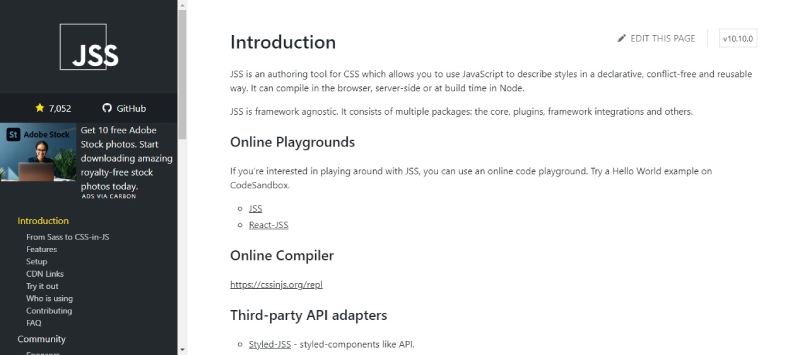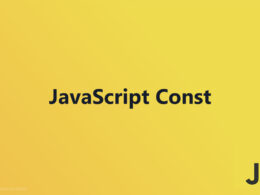Trending CSS-in-JS Libraries for Developers

When the canvas of the web beckoned for a dash of artistry, CSS-in-JS libraries emerged as the avant-garde. As if mixing potions, developers blend the dynamic prowess of JavaScript with the styling finesse of CSS, concocting interfaces that are both functional and aesthetic.
The surge in popularity of these libraries isn’t just a fleeting trend—it’s a testament to an evolving paradigm in web development.
Dive into this exploration, and you’ll be well-equipped with insights into the pivotal role these libraries play in sculpting today’s digital ecosystem.
As you proceed, you’ll grasp the intricacies of Styled-components, Emotion JS, and their ilk, and how they’ve revolutionized the way we approach styling in React applications and beyond.
Expect to emerge on the other side of this text odyssey, fluent in the language of dynamic styling, with a map charting the landscape of front-end development.
Through component-based architecture to theme UI, grasp the quintessence of CSS-in-JS libraries and why they are indispensable for contemporary web design.
CSS-in-JS Libraries
| CSS-in-JS Library | Library Type | Popularity | Special Features | Consideration Points |
|---|---|---|---|---|
| Emotion | Library | High | Supports both string and object styles, theming, composition | Performance, community support |
| JSS | Library | Moderate | Dynamic styling, plugins, SSR support | Learning curve, integration efforts |
| Bulma | CSS Framework | High | Modern UI components, modular, variables via Sass | Not CSS-in-JS, relies on Sass |
| Bootstrap | CSS Framework | Very High | Broad component library, extensive documentation | Not CSS-in-JS, can be heavy |
| Styletron | Library | Moderate | Atomic CSS, performance-focused | Specific to React, stylisitic constraints |
| React | Library/UI Framework | Very High | Component-based UI building | Not a CSS-in-JS library, JS-based UI library |
| Foundation | CSS Framework | High | Professional, enterprise-grade frontend framework | Not CSS-in-JS, might be overkill for some projects |
| Panda | Unknown/Not Specified | Low/Unknown | Insufficient data | Insufficient data |
| Cssinjs | Approach/Concept | — | General term for CSS-in-JS, not a specific library | — |
| Animate CSS | Library/Add-on | High | Ready-to-use cross-browser animations | Not CSS-in-JS, lacks dynamic styling |
| Radium | Library | Moderate | Inline styling with pseudo-class and media query support | Focused on React, may not have active development |
| Styled-components | Library | Very High | Theming support, tagged template literals | Potential performance considerations |
| Tamagui | Framework | Low/New | Optimized for design systems, cross-platform | Newer with less community adoption |
| CSS | Language | — | Fundamental web styling language | Not a library or framework |
| Tailwind CSS | Utility-first CSS Framework | Very High | Utility classes, highly customizable | Not CSS-in-JS, requires different mindset |
| Toadflax | Unknown/Not Specified | Low/Unknown | Insufficient data | Insufficient data |
| Aphrodite | Library | Moderate | Supports pseudo-classes and media queries | Focused on React, may not have active development |
| Picnic CSS | CSS Library | Low | Lightweight and modular | Not CSS-in-JS, more traditional approach |
Emotion
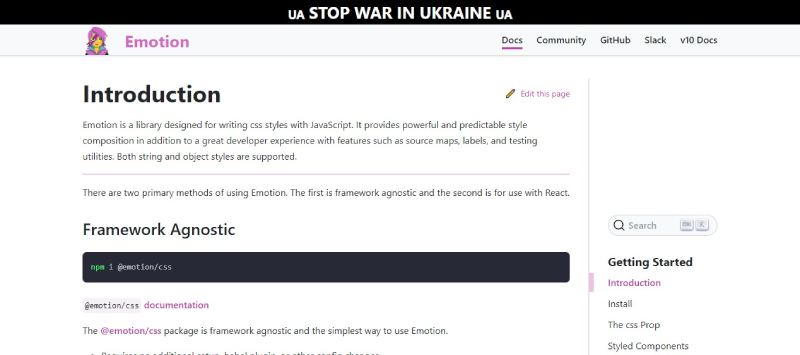
Emotion is a library designed for writing css styles with JavaScript. It’s a powerful tool for composing component-based designs. By leveraging the flexibility of JavaScript, it offers a rich styling environment that adapts to the dynamics of application state with ease.
Best Features:
- Dynamic styling
- Server-side rendering
- Composition-first approach
What we like about it: Its ability to merge themes and styles on-the-fly makes it an indispensable asset when crafting reactive user interfaces, bridging the gap between dynamic data and design.
JSS
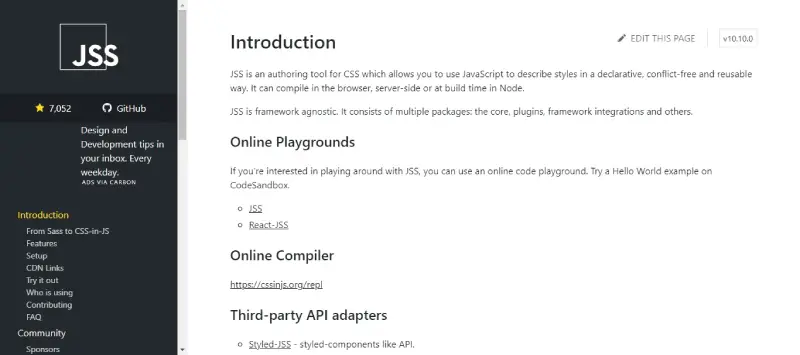
JSS is an abstraction layer for CSS, allowing you to use JavaScript to describe styles in a declarative, conflict-free, and reusable way.
Best Features:
- Plugin-driven architecture
- Full CSS support
- Theming and dynamic styles
What we like about it: Writing real CSS within JavaScript, so the familiarity of CSS combined with the power of JS brings a comfortable yet potent styling ecosystem.
Bulma
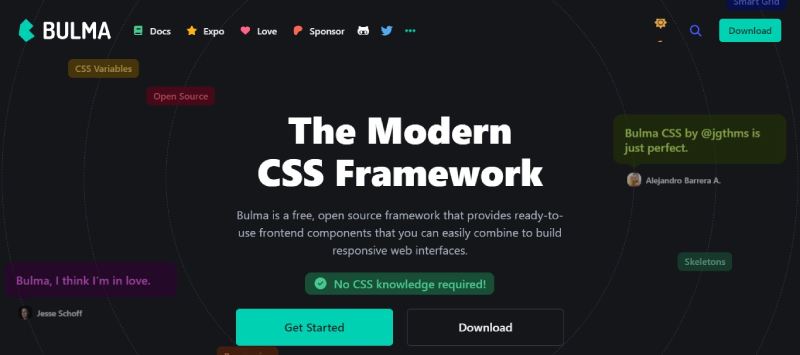
Bulma is a modern CSS framework based on Flexbox, providing ready-to-use frontend components that you can easily combine to build responsive web interfaces.
Best Features:
- Modern Flexbox grid
- Modular and customizable
- Well-documented
What we like about it: The ease of customization without JavaScript, allowing for a purely CSS approach that’s both straightforward and developer-friendly, trimming down the complexity of interface design.
Bootstrap

Bootstrap is a pioneering front-end framework using HTML, CSS, and JavaScript. It offers a grid system, pre-styled components, and powerful plugins to kickstart responsive website development.
Best Features:
- Extensive component library
- Comprehensive grid system
- Wide community support
What we like about it: Bootstrap’s vast array of components and extensive documentation helps create sophisticated layouts rapidly, making it a go-to for efficiency.
Styletron
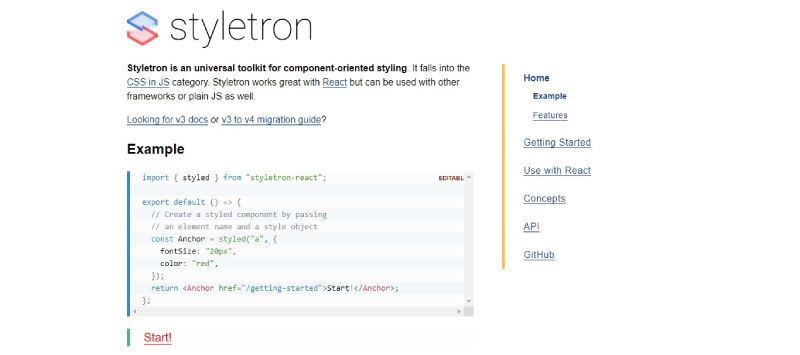
Styletron is a CSS-in-JS engine that generates performant styles by creating atomic CSS. It’s designed to be high-performing and provides an innovative approach to handling styles in modern web applications.
Best Features:
- Atomic CSS generation
- Performance-focused
- Server-side rendering capabilities
What we like about it: Its atomic CSS approach minimizes redundancy, ensuring that each unique property-value pair is generated only once throughout the application, promoting efficiency and speed.
React

While not a CSS-in-JS library, React plays a pivotal role in the ecosystem by serving as the foundation for many styling libraries. It’s a JavaScript library for building user interfaces, promoting component-based development.
Best Features:
- Reusable components
- Unidirectional data flow
- Vast ecosystem of libraries
What we like about it: React is where many CSS-in-JS libraries like Styled-components, and Emotion find their home, turning React’s component logic into a powerful styling realm, where design meets functionality.
Foundation

Foundation is a sophisticated front-end framework designed for developing responsive, mobile-first websites with ease. It’s an industry-standard tool that aims to streamline web development with an array of customizable features.
Best Features:
- Mobile-first approach
- Customizable yet uniform grid system
- Accessibility features
What we like about it: Its focus on accessibility and responsible web practices impresses, ensuring the creation of websites that are not only beautiful but also widely accessible.
Panda

Panda is a playful CSS-in-JS solution, delivering a whimsical spin on styling web components. The library puts the fun back into web design, embracing the dynamic nature of JavaScript to produce vibrant, animated interfaces.
Best Features:
- Simplified syntax for animations
- Lightweight and fast
- Intuitive design process
What we like about it: The animation capabilities stand out, enabling developers to inject life into static designs with minimal fuss.
Cssinjs
Cssinjs, often referred to as JSS, offers a powerful concoction of JavaScript and CSS that results in a robust style solution for modern JavaScript applications. It shifts paradigms by treating styles as data, which can be manipulated accordingly.
Best Features:
- Full encapsulation of CSS in JS
- Dynamic styling and theming
- React integration
What we like about it: Developers often laud its ability to handle dynamic themes, which facilitates the creation of responsive and interactive user experiences that adapt to user preferences and behaviors in real-time.
Animate CSS
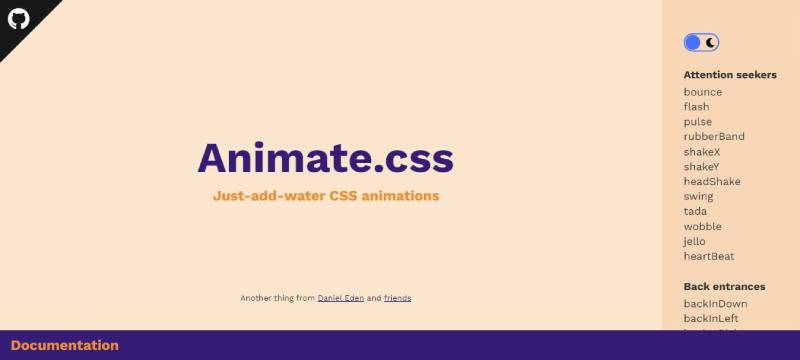
Animate CSS adds a spark of life to web elements with its collection of pre-defined animations. This library is a straightforward way to introduce subtle interactions and transitions that enrich user experiences.
Best Features:
- Easy to implement
- Broad range of animations
- CSS-based simplicity
What we like about it: The effortless integration that brings an instant visual uplift to web projects, making animations accessible even to those not deeply versed in the complexities of JavaScript or advanced CSS.
Radium

Radium extends the styling capacities of CSS in React applications, emphasizing interactive styles such as hover, media queries, and dynamic states within your components.
Best Features:
- Inline styling enhancements
- Pseudo-class capabilities
- Media query support
What we like about it: Its pseudo-class and media query support is especially laudable; they extend the functionality of inline styles beyond their native capabilities, offering greater flexibility and interactivity.
Styled-components
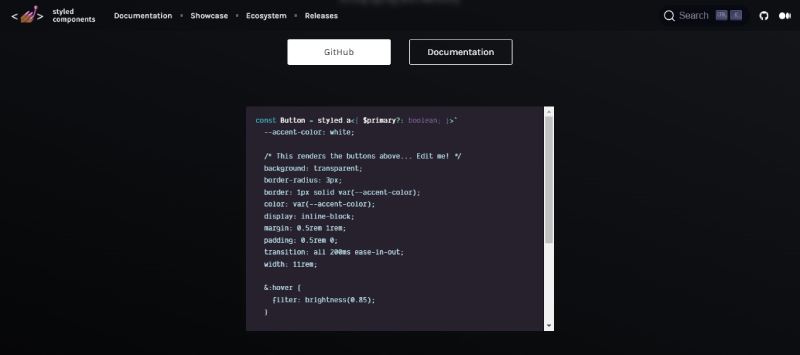
Styled-components streamline the application of styles in a JavaScript environment, promoting a seamless integration with the component logic found in libraries such as React, enhancing modularity and theme adaptability.
Best Features:
- CSS encapsulation in JS components
- Seamless theming
- Easy to use syntax
What we like about it: Its syntax resembles actual CSS, making it an easy transition for those familiar with CSS to adopt a CSS-in-JS approach, bridging familiar territory with new potentials.
Tamagui
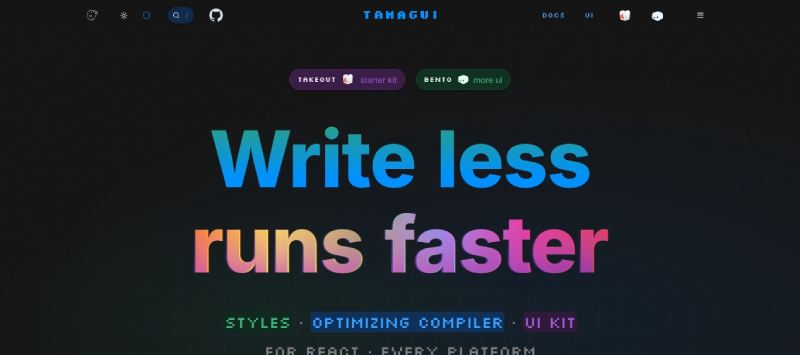
Tamagui is a relatively new player in the CSS-in-JS space focused on performance and scalability, especially when dealing with design systems across platforms like web and native.
Best Features:
- Cross-platform consistency
- Theming and token system
- Optimization for large-scale projects
What we like about it: The most praised feature is its ability to maintain design consistency across different platforms, ensuring that the user interface remains uniform whether on a mobile app or a web page.
CSS

CSS, or Cascading Style Sheets, is the cornerstone of web design, defining the look and feel of a website. While not a library itself, it’s the underlying technology that all CSS-in-JS libraries build upon.
Best Features:
- Universal browser support
- Intuitive styling language
- Powerful layout designs
What we like about it: CSS’s vastly supported and standardized nature ensures that designs crafted with it are future-proof, interoperable, and can reach a wide audience without compatibility concerns.
Tailwind CSS
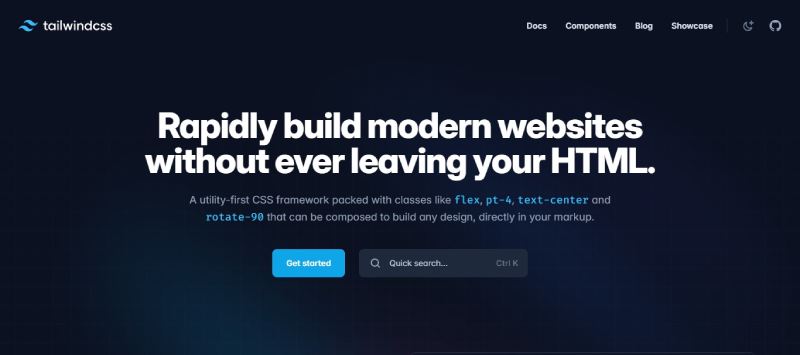
Tailwind CSS is a utility-first CSS framework that provides low-level style customization, encouraging developers to craft unique designs without leaving the HTML markup.
Best Features:
- Utility-first approach
- Highly customizable
- Responsive design friendly
What we like about it: Rapid UI development with its utility classes strikes a chord with those who prefer design-in-template rather than separate stylesheets, which speeds up prototyping and reduces the need for custom CSS.
Picnic CSS
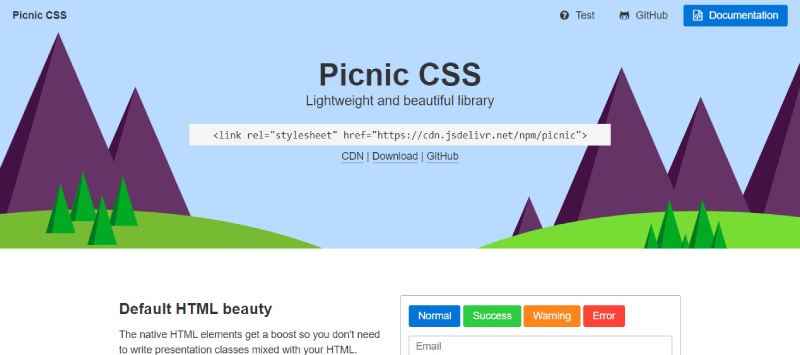
Picnic CSS is a lightweight and beautiful library that strives to leverage native browser features to provide a robust base for designing web applications, potentially reducing the complexity usually associated with front-end frameworks.
Best Features:
- Easy to learn
- Minimalistic approach
- Modern browser capabilities
What we like about it: Its emphasis on simplicity and utilizing native HTML elements appeals to those who aim for a minimalist and clean aesthetic without the bloat of more extensive frameworks.
FAQ On CSS-in-JS Libraries
What exactly are CSS-in-JS libraries?
CSS-in-JS is a styling technique where JavaScript is used to style components. It encapsulates styles within components, ensuring isolation and scalability. Libraries like Styled-components and Emotion JS are the backbone, enabling dynamic styling effects with JavaScript’s full capability.
How do CSS-in-JS libraries improve workflow in web development?
They streamline development with component-based architecture. No context switching between JS and CSS files; styling logic stays alongside component logic.
This leads to enhanced developer experience and faster development cycles. Reusable styles and theme management become painless, adding efficiency and consistency to one’s workflow.
Why use CSS-in-JS over traditional CSS?
Using CSS-in-JS means fewer worries about style conflicts, as CSS scoping is handled automatically. It also allows for dynamic styles that react to state changes. It’s about harnessing the power of JavaScript to write styles in a way that’s more maintainable and scalable.
Do CSS-in-JS libraries support server-side rendering?
Absolutely. Most CSS-in-JS libraries, such as Styled-components, have server-side rendering capabilities. This feature enables faster load times and a boost in performance by generating CSS on the server, pushing a styled page to the client.
How does CSS-in-JS handle media queries and responsiveness?
Just as with traditional CSS, media queries are a cornerstone. Libraries often provide APIs to integrate media queries within the style definitions of components, maintaining the responsiveness without breaking the component’s encapsulated styling spirit.
What about performance? Aren’t CSS-in-JS libraries slower?
There’s a belief that adds weight due to additional JavaScript. But in practice, the impact is minimal for most applications.
Developers can optimize performance by leveraging techniques like critical CSS extraction and minimizing runtime overhead, ensuring web applications remain snappy.
Can I apply global styles with CSS-in-JS libraries?
While the focus is on component-level styles, global styling isn’t cast aside. Many libraries offer global styling mechanisms to set site-wide defaults, ensuring that foundational styles are still within reach.
Do CSS-in-JS libraries work well with design systems?
They’re a perfect match. Stylized components from such libraries fit seamlessly into design systems, promoting a unified theme and properties that cascade across all components. This synergy builds a robust design language reproducible throughout the development process.
How do CSS-in-JS libraries interface with existing CSS frameworks?
There’s a harmonious way libraries interact with existing frameworks. They can complement each other—utilize a CSS framework for baseline styles, and CSS-in-JS for component-level custom styles. It’s about playing to the strengths of both worlds for an elegant styling solution.
What’s the future of CSS-in-JS libraries?
They’ve not hit a crescendo. As user interface complexities grow, so does the need for sophisticated styling solutions. With community-driven evolutions and innovations, the trajectory is set towards more efficient, more powerful libraries—fundamental tools in the modern front-end developer’s arsenal.
Conclusion
Woven into the vast tapestry of web development, CSS-in-JS libraries stand out, marrying style with substance. They’ve redefined the norms, bringing inline styling and the power of JavaScript together to push the boundaries beyond the conventional.
- The elegance of Styled-components
- The robustness of Emotion JS
- The fluidity of dynamic theming
Each is like a thread in a richly embroidered quilt, integral to the overarching design.
In this journey, we’ve unraveled the how and why of CSS-in-JS, uncovering the delicate balance of performance, server-side rendering prowess, and the ability to weave responsive designs seamlessly. It’s about styling components with precision, without losing sight of the big picture—a symphony of styles harmoniously orchestrated.
As the curtain falls, it’s clear that the essence of these libraries isn’t just in their technical merits; it’s in their capability to bring ideas to life, through a tapestry of code that is as performant as it is aesthetically pleasing. It’s about crafting experiences, pixel by pixel, in a world that’s constantly in motion.
If you liked this article about CSS-in-JS libraries, you should check out these articles also:
- Comics and Stories: Top Apps Like Webtoon for Readers
- Flexible Payment Plans: Discovering Apps Like Sezzle
- Hire Local Professionals: Apps Like Thumbtack Reviewed
- The Difference Between Methods and Functions in JavaScript - June 24, 2024
- Sing Along: Karaoke and Music Apps Like Smule - June 23, 2024
- How to Optimize JavaScript Function Call Performance - June 23, 2024





